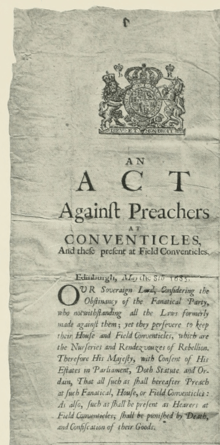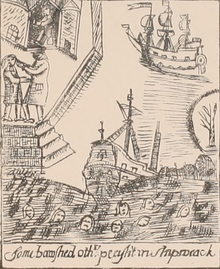Robert Dick (salt-grieve)
Robert Dick of Prestonpans was a 17th-century merchant and inspector of salt works to Lord Carringtoune.[2] He was arrested on 4 September 1676 for attending an open-air service in the Pentland Hills.[3]
Robert Dick | |
|---|---|
| Personal | |
| Religion | Christianity |
| School | Presbyterianism |
| Profession | merchant, salt-grieve |
| Senior posting | |
| Profession | merchant, salt-grieve |

Charges
While they were carried up the West Bow at Edinburgh, along with William Bell, an unsuccessful attempt was made at a rescue, and all were imprisoned.[4][5] He refused to give his oath at his trial on 12 October and was sent to the Bass Rock on the Firth of Forth in Haddingtonshire along with William Bell.[6][7][8] In October, 1676, he was charged, before the Privy Council, for "convocating disorderly and seditious meetings" at Pentland Hills and divers other places. William Bell was charged with preaching and Dick's crime was that he did "convocat the people therto".(Brown pg. 44)[5] The list of conventicles and charges included: "the Pentland Hills, Caldermuir, Drumshoirling Muir, Kirklistoune (Kirkliston), Borthwick, Edmonstoune Chaple, Woolmett, Corstorphin, Torwood, Gledsmuir, Dumbarr, Whythill, Eistbarnes, Broxburne, Newtounlees, and several other places,or at one or other of them or near thereto, and not only heard outed ministers preach but took upon them to convocate people from Edinburgh and elsewhere to the said meetings." Dick admitted having been present at the Pentland conventicle but refused to depone, upon oath, any connexion with the others. This the Council regarded as equivalent to a plea of "Guilty," and he was, accordingly, relegated to the dungeons of the Bass.[9] After two years of rigorous imprisonment he was again brought before the Council, in September 1678, on the "foresaid libel."[10] Dick, however, still refused to incriminate himself; and, for his contumacy he was banished to the plantations of the West, where probably he ended his days in slavery.[11]
Family

Nothing much is known about his family although some research was done on the subject.[12]
Another Covenanter called Robert Dick appears to have been killed at Airsmoss and has an unusual tombstone there.[13][14]
References
- Hewison, James King (1908). The Covenanters, a history of the church in Scotland from the Reformation to the Revolution. 2. Glasgow: J. Smith. pp. 413–454. Retrieved 16 July 2019.CS1 maint: ref=harv (link)
- Brown, P. Hume (1912). The register of the Privy Council of Scotland (3rd series: vol. 5 1676/1678 ed.). Edinburgh: Published By The Authority Of The Lords Commissioners Of His Majesty's Treasury, Under The Direction Of The Deputy Clerk Register Of Scotland. H.M. General Register House. pp. 47–48. Retrieved 9 April 2019.
- Wodrow, Robert (1828). The history of the sufferings of the church of Scotland from the restoration to the revolution, with an original memoir of the author, extracts from his correspondence, and preliminary dissertation. Glasgow: Blackie, Fullarton & co. p. 482. Retrieved 12 February 2019.
- Porteous, James Moir (1881). The Scottish Patmos. A standing testimony to patriotic Christian devotion. Paisley: J. and R. Parlane. pp. 49–50. Retrieved 3 March 2019.

- Brown, P. Hume (1912). The register of the Privy Council of Scotland (3rd series: vol. 5 1676/1678 ed.). Edinburgh: Published By The Authority Of The Lords Commissioners Of His Majesty's Treasury, Under The Direction Of The Deputy Clerk Register Of Scotland. H.M. General Register House. p. 40. Retrieved 9 April 2019.
- Wodrow, Robert (1828). The history of the sufferings of the church of Scotland from the restoration to the revolution, with an original memoir of the author, extracts from his correspondence, and preliminary dissertation (Vol. 2). Glasgow: Blackie, Fullarton & co. p. 335. Retrieved 12 February 2019.
- M'Crie, Thomas, D.D. the younger (1847). The Bass rock: Its civil and ecclesiastic history. Edinburgh: J. Greig & Son. pp. 121–123. Retrieved 11 February 2019.
- Crookshank, William (1749). The history of the state and sufferings of the Church of Scotland, from the Restoration to the Revolution. With an introd., containing the most remarkable occurrences relating to that Church from the Reformation. London: J. Oswald [etc.] p. 398. Retrieved 2 March 2019.
- Gray, W. Forbes; Jamieson, James H. (1941). East Lothian Biographies - Transactions Of The East Lothian Antiquarian And Field Naturalists' Society (PDF) (Fourth Volume ed.). Haddington: D. & J. Croal. p. 43.
- Phillimore, R.P (1911). The Bass Rock : its history and romance. North Berwick, Scotland. p. 99. Retrieved 21 March 2019.
- Dickson, John (1899). Emeralds chased in Gold; or, the Islands of the Forth: their story, ancient and modern. [With illustrations.]. Edinburgh and London: Oliphant, Anderson & Ferrier. pp. 205–206. Retrieved 3 March 2019.

- "Family of Robert Dick, the Covenanter". Scottish notes and queries. Series 2, Volume 5 (Aberdeen : D. Wyllie and Son): 43, 63. 1903. Retrieved 9 April 2019.
- Johnston, John C (1887). Treasury of the Scottish covenant. Edinburgh : Andrew Elliot. pp. 590, 597, 618. Retrieved 9 April 2019.
- Gibson, James. Inscriptions on the tombstones and monuments erected in memory of the Covenanters; with historical introduction and notes. Glasgow: Dunn. pp. 186–187. Retrieved 9 April 2019.
